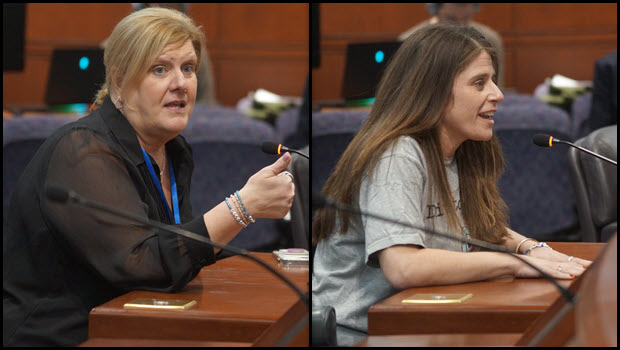The legislature’s Education Committee held a public hearing on two bills today—one focusing on disengaged youth and one concerning additional funding for education.
CEA President Kate Dias explained to legislators that the two go hand-in-hand.
“The irony is not lost on me that we’re once again fighting for funding at the state level and in towns around the state. We’re also talking about the impact of those funding cuts, which is disconnected youth,” she said.
The bill on disconnected youth proposes measures to address the issue including reevaluating the ways in which we assess students and hold schools accountable, promoting cooperation among nonprofits and agencies delivering essential services, providing free city bus service for safe passage to school, expanding access to credit recovery and dual-credit opportunities, and more.
Carrie Cassady, a sixth grade science teacher in Stonington, told legislators that, while the bill on disconnected youth takes important steps, there’s more to consider.
“I work with students who are disconnected. They’re not engaged at school. It’s not just a high school issue—it impacts classrooms at every level,” Cassady said. She explained that she’s had a handful of disconnected students every year that she’s taught, but that the number has grown since the pandemic.
“We need to find new ways to engage students at every level to give them ways to participate in our communities. We need to break through the barriers that keep students from being successful in school and in life,” she said.
Bloomfield Education Association President Gail Jorden, an academic interventionist, told the Education Committee that, over her 17 years teaching in Bloomfield, she has lost four former students to violent deaths, has two former students who survived very violent encounters, and two who are incarcerated. She knows other former students who are not currently employed or did not graduate high school.
“The issue of disengaged youth is near and dear to my heart,” Jorden said. “I’m the teacher who, once you’re my student, you’re forever my student.”
She continued, “When a student comes to me and is struggling, I may or may not know what programs to recommend to them. It shouldn’t be about who you know in order to get supports.”
Jorden said she thinks the proposed bill would allow for more connection across the state when it comes to services that could be provided to youth.
“I work with fifth and sixth graders and, even at this young age, I can see the disconnect starting to happen,” she said. “This past week we’ve worked on bringing some football players to the school to celebrate Read Across Connecticut and to try to reignite these students through a different lens and giving them some different experiences. Each teacher is only one teacher, and if we were able to have a list available to know what supports there are across the state, I think it would be truly helpful.”
Dias said the alternative education program where she began her teaching career provided a lifeline for many disconnected students, allowing them to get back on track with their education and graduate high school. The program was eventually eliminated due to budget cuts.
“These two issues are so closely linked,” Dias said. “What we really want to see is full funding of our public schools so that we have the opportunity to do amazing work.”
CEA Vice President Joslyn DeLancey told Education Committee members, “Our investment in our public education system and in our teachers and in our students directly impacts our ability to connect and engage with our students. The legislature passed many bills last year that we’re so grateful for—play-based learning, evolving our teacher evaluation system, looking at school climate. All of those things will impact our ability to connect with our students, but we won’t see that impact for a long time.”
DeLancey referenced the Dalio Report on disconnected youth, the impetus for the bill discussed at today’s hearing, which found 119,000 young people in Connecticut have either dropped out of school or are in danger of dropping out of school, and, among those aged 18 to 26, are unemployed.
“I think about the students in the Dalio report, some of them are in their 20s. When I think about when they started their academic career, it was in the early 2000s. That was when we put No Child Left Behind in place—and we can see how well that turned out,” DeLancey said.
She continued, “We have to look at the investment we’re putting forward. What we know impacts our engagement with students the most is connected, engaged, and supported educators. We need to ensure that we’re securing the funding we need to do this work.”
The Education Committee will be hearing more bills of importance to students and teachers next week. Subscribe to the CEA Daily to learn how you can share your experiences with legislators at upcoming hearings.







